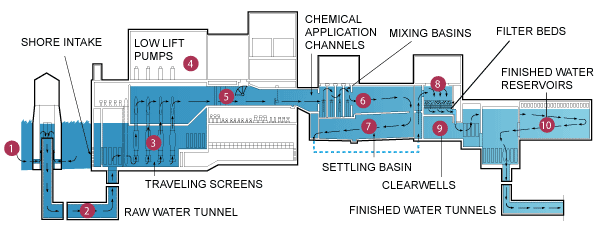Water Treatment
Lake Michigan, by volume, is the second largest Great Lake and the only one located totally within the United States. It serves as our source of drinking water, as a place for recreation and is our most precious natural resource.

THE WATER TREATMENT PROCESS
- Water from Lake Michigan enters the intake crib at depths of 20 to 30 feet.
- Water enters the purification plant's intake basin through a tunnel beneath the lake bed.
- Water is filtered through eight traveling screens to catch debris.
- Water is pumped by low-lift pumps up to 25 feet for the first chemical treatment.
- Water flows from the chemical application channels.
- Water flows through mixing basins to begin the flocculation process.
- Flocculated water passes into settling basins to sit for hours allowing floc to settle.
- Water is filtered through precisely graded sand and gravel performing a "natural polishing".
- Filtered water flows into clearwells for its final chemical application.
- From finished water reservoirs water flows to the distribution system.
The treatment process performed by the Chicago Department of Water Management (DWM) makes the water safe for people to drink. In nature, water is not always clean enough for people to drink. When the microscope was invented in the 1850s, germs could be seen in water for the first time. In 1902, Belgium was the first country to use chlorine to clean or treat water in a public water supply. Today, almost every city in the world treats their drinking water. Treatment includes disinfection with chlorine or other chemicals to kill any germs in the water.
DWM tests water composition from every point in our system and adjusts the water treatment with the mix of chemicals applied in the purification process.
Our pumping stations distribute pressurized water throughout our city. Chicago's water treatment plants are big enough that we don’t need water storage towers that are seen in smaller communities. A few of the suburbs we serve do use towers so that pressure is supplied by gravity and kept uniform.
We use several chemicals in the purification and treatment of water:
Chlorine: to disinfect the water.
Aluminum Sulfate or Alum and Polymer: for coagulation to settle out impurities.
Blended Polyphosphate: to coat pipes and prevent lead leaching.
Activated Carbon: to remove unpleasant tastes and odors.
Fluoride: to help fight cavities in children's teeth.
The chemical amounts are quite small. The total volume needed to treat 100 gallons of water is about a teaspoon full. That's 15 parts of chemical to 1 million parts of water.
